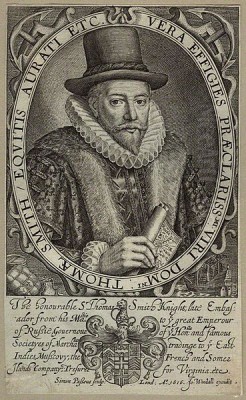
Thomas Smythe stands as a notable figure within the rich tapestry of 19th-century British art. Active during the Victorian era, he dedicated his career primarily to capturing the landscapes, rural activities, and everyday life of East Anglia. His detailed and evocative paintings, often rendered in oil, continue to attract interest from collectors and offer valuable visual insights into the English countryside of his time. While not as revolutionary as some of his contemporaries, Smythe's consistent output and focus on specific regional themes secured him a distinct place in British art history.
Life and Artistic Context
Born in 1825, Thomas Smythe lived through a period of significant change in Britain, witnessing the height of the Victorian era and the cusp of the modern age before his death in 1906. Detailed biographical information about his personal life, education, or specific training remains somewhat scarce compared to more prominent artists of the period. However, it is known that he was part of an artistic family based primarily in Ipswich, Suffolk. His brother, Edward Robert Smythe (1810-1899), was also a respected painter, known for similar subjects, and the two often worked in related styles, sometimes leading to confusion in attributions.
Thomas Smythe operated within a thriving British art scene. The Victorian era saw a burgeoning middle class with an appetite for art, particularly landscapes and genre scenes that depicted familiar, often idealized, visions of British life and the countryside. Academies and public exhibitions flourished, providing platforms for artists like Smythe to showcase and sell their work. His career unfolded against the backdrop of established landscape traditions, notably the enduring influence of earlier masters who had celebrated the British countryside.
The East Anglian Focus
Thomas Smythe is inextricably linked with the landscapes and coastal regions of East Anglia, particularly Suffolk and Norfolk. This area, with its distinctive flatlands, winding rivers, broad skies, estuaries, and charming villages, had already been immortalized by earlier artists, most famously John Constable and the painters of the Norwich School, such as John Sell Cotman and John Crome. Smythe continued this tradition, finding endless inspiration in the region's specific geography and rural character.
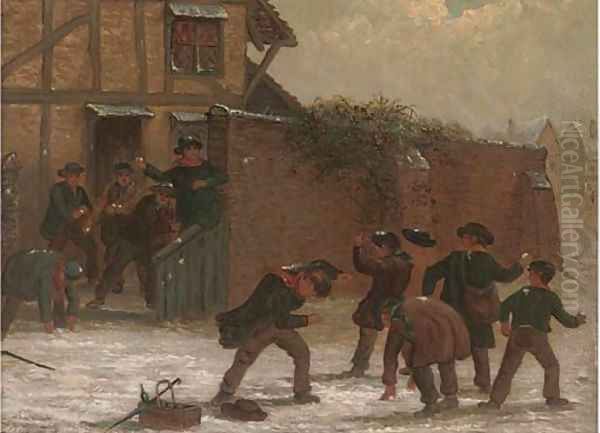
His paintings often depict the Suffolk coastline, the activities of local fishermen and farmers, and the gentle rhythm of village life. He seemed particularly drawn to the interplay of light and atmosphere unique to the area. Whether capturing the crisp air of a winter morning, the gentle light of a summer afternoon, or the bustling activity of a market day, Smythe's work serves as a detailed visual record of East Anglia before the significant transformations of the 20th century. His dedication to this specific locale provides a focused lens through which we can view the region's past.
Style and Technique
Smythe worked firmly within the Victorian tradition of representational painting. His style is characterized by careful observation and a high degree of detail. He rendered landscapes with accuracy, paying close attention to the textures of foliage, the structure of buildings, and the specific conditions of weather and light. Figures and animals, particularly horses and dogs, are integral parts of his compositions and are depicted with anatomical correctness and a sense of life. His horses, often shown working or resting, are particularly well-regarded.
His technique primarily involved oil on canvas, applying paint smoothly to achieve a detailed finish. While not generally considered an innovator in technique, his skill lay in his ability to compose balanced and engaging scenes. Narrative often plays a key role; his paintings frequently tell a small story or depict a specific moment in time – a snowball fight, travellers resting, market vendors setting up. There is often a picturesque or charming quality to his work, aligning with Victorian tastes for accessible and relatable subject matter. Winter scenes were a recurring theme, allowing him to explore the effects of snow and frost on the landscape and depict associated human activities.
Notable Works
Several specific works highlight Thomas Smythe's typical subjects and style, many of which have appeared at auction, confirming their existence and market presence:
The Snowball Fight: This title suggests a lively winter genre scene, likely featuring figures engaged in playful activity within a snow-covered landscape. Such works appealed to Victorian sentimentality and the appreciation of seasonal depictions. The recorded size of 30cm x 54.5cm indicates a moderately sized cabinet painting, suitable for domestic display.
Figures in a River Landscape: This painting (14” x 18”) likely showcases Smythe's skill in combining landscape elements with human presence. It probably depicts individuals near a waterway, perhaps boating, fishing, or simply enjoying the riverside scenery typical of East Anglia.
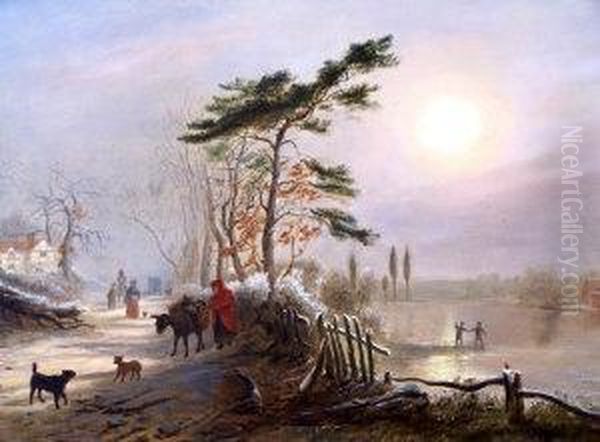
A Traveller with his Dog in a Winter Landscape: A smaller oil (14.5 x 18.2 cm), this work points to another favourite theme – the solitary figure or small group navigating the challenges or beauty of the winter countryside. The inclusion of a dog adds a touch of companionship and narrative interest, common in Smythe's oeuvre.
Figures in a Camp: This title (8.25” x 15”) might refer to a scene involving gypsies or travellers, a subject occasionally explored by Victorian genre painters, offering a glimpse into lives lived outside settled village communities.
The Monkey Entertainer and The Punch & Judy Show: These titles indicate Smythe's interest in depicting popular entertainment and street life. Such scenes provided opportunities for lively figure compositions and social observation, capturing aspects of Victorian popular culture.
Snow Covered Landscapes, Homeward Bound: This title reinforces his affinity for winter scenes and narrative elements, likely depicting figures or animals making their way home through the snow at the end of the day, evoking feelings of warmth and shelter contrasted with the cold outdoors.
Family Group and a wagon in a lane: This suggests a quintessential rural scene, combining figures, animals (likely horses), and a specific countryside setting – a lane – typical of his detailed depictions of agricultural life and travel in East Anglia.
These titles collectively paint a picture of an artist deeply engaged with the visual world around him, focusing on rural activities, seasonal changes, and the human and animal inhabitants of the East Anglian landscape.
Contemporaries and Artistic Milieu
Thomas Smythe worked during a period populated by numerous landscape and genre painters catering to the Victorian market. While distinct in his specific focus, his work can be understood in relation to several contemporaries and predecessors:
John Constable (1776-1837) and J.M.W. Turner (1775-1851): Though largely preceding Smythe, these giants of British landscape painting set standards and explored themes (especially Constable's focus on Suffolk) that resonated throughout the 19th century.
The Norwich School: Artists like John Crome (1768-1821) and John Sell Cotman (1782-1842) established East Anglia as a major centre for landscape painting, influencing subsequent generations, including Smythe.
William Shayer Snr. (1787-1879): A popular painter of southern English rural and coastal scenes, often featuring rustic figures and animals, working in a detailed style somewhat comparable to Smythe's.
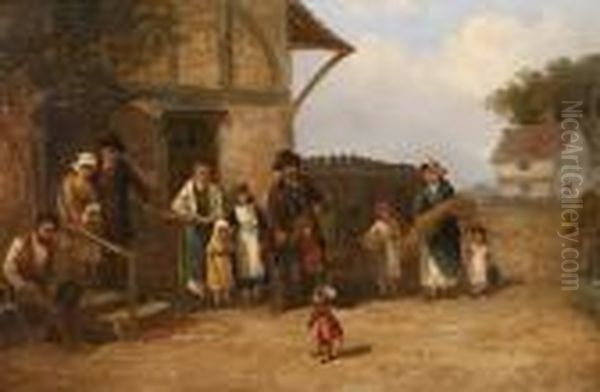
John Frederick Herring Snr. (1795-1865) and John Frederick Herring Jnr. (1820-1907): Renowned for their depictions of horses, farmyard scenes, and sporting subjects, their work shares Smythe's interest in animal painting and rural life.
Frederick William Hulme (1816-1884): A prolific landscape painter known for his detailed woodland and river scenes, popular during the mid-Victorian period.
Benjamin Williams Leader (1831-1923): Highly successful Victorian landscape painter, known for his picturesque views, particularly of Worcestershire and Wales, often with a sentimental or atmospheric quality.
Sidney Richard Percy (1821-1886): Part of the Williams family of painters, known for his popular landscapes of Wales, Scotland, and the Lake District, characterized by detailed foliage and often dramatic lighting.
Alfred Augustus Glendening Snr. (fl. 1861-1903): Painted landscapes and river scenes in a detailed, often brightly lit style, sharing the Victorian taste for picturesque representation.
George Augustus Williams (1814-1901): Another member of the Williams family, known for moonlit river scenes and landscapes.
Heywood Hardy (1842-1933): Known for his 18th-century genre scenes, sporting subjects, and animal paintings, overlapping with Smythe in his skilled depiction of animals and narrative focus.
Placing Smythe among these artists helps to define his position: less dramatic than Turner, less focused on light effects than Constable, but a solid and skilled practitioner within the popular Victorian mode of detailed, narrative, and regionally focused landscape and genre painting, with a particular strength in depicting the character of East Anglia and its animal inhabitants.
Legacy and Market Presence
Thomas Smythe's legacy lies primarily in his dedicated portrayal of East Anglian life and landscape during the Victorian era. His works serve as valuable historical documents, capturing details of rural work, leisure, architecture, and the appearance of the countryside before widespread mechanization and development. He successfully catered to the tastes of his time, producing accessible, well-crafted paintings that found a ready market.
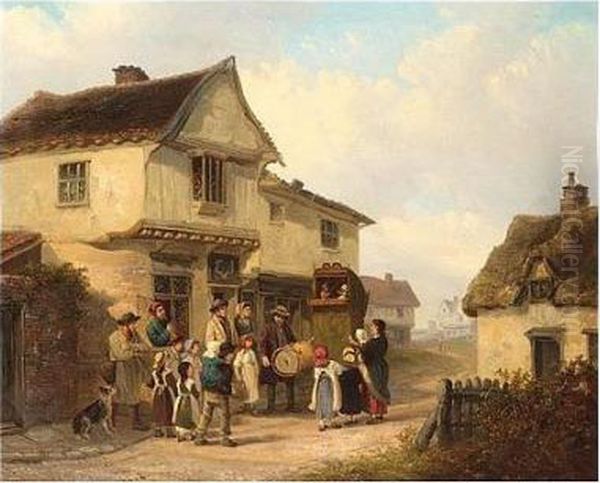
Today, his paintings continue to be appreciated by collectors of traditional British art. As noted in auction records, his works appear regularly on the market, with prices typically ranging from several hundred to several thousand pounds, depending on the size, subject matter, condition, and quality of the specific piece. Winter scenes and those featuring well-painted horses often command higher interest. While perhaps not a household name on the scale of Constable or Turner, Thomas Smythe remains a respected and sought-after regional artist whose work offers a charming and detailed window onto a bygone era of English rural life.
Conclusion
Thomas Smythe (1825-1906) was a quintessential Victorian artist, specializing in the landscapes and genre scenes of his native East Anglia. Working primarily in oils, he developed a detailed and observant style, capturing the specific atmosphere, activities, and inhabitants of the Suffolk and Norfolk countryside. His depictions of rural labour, village life, coastal activities, and particularly winter landscapes filled with figures and animals, resonated with the tastes of his time. Though part of a large cohort of Victorian landscape painters, his consistent focus on East Anglia and his skill in rendering narrative scenes and animals secure his place as an important regional artist. His works remain popular with collectors today, valued both for their artistic merit and as evocative records of 19th-century English provincial life.